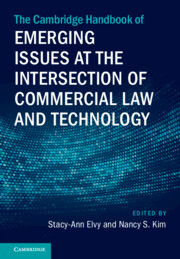Refine search
Actions for selected content:
48584 results in Computer Science
19 - The Use of Algorithmic Systems by Public Administrations
- from Part III - AI across Sectors
-
-
- Book:
- The Cambridge Handbook of the Law, Ethics and Policy of Artificial Intelligence
- Published online:
- 06 February 2025
- Print publication:
- 13 February 2025, pp 383-410
-
- Chapter
-
- You have access
- Open access
- HTML
- Export citation
9 - Artificial Intelligence and Competition Law
- from Part II - AI, Law and Policy
-
-
- Book:
- The Cambridge Handbook of the Law, Ethics and Policy of Artificial Intelligence
- Published online:
- 06 February 2025
- Print publication:
- 13 February 2025, pp 174-191
-
- Chapter
-
- You have access
- Open access
- HTML
- Export citation
16 - Artificial Intelligence and Financial Services
- from Part III - AI across Sectors
-
-
- Book:
- The Cambridge Handbook of the Law, Ethics and Policy of Artificial Intelligence
- Published online:
- 06 February 2025
- Print publication:
- 13 February 2025, pp 322-338
-
- Chapter
-
- You have access
- Open access
- HTML
- Export citation
Dedication
-
- Book:
- The Cambridge Handbook of the Law, Ethics and Policy of Artificial Intelligence
- Published online:
- 06 February 2025
- Print publication:
- 13 February 2025, pp v-vi
-
- Chapter
-
- You have access
- Open access
- HTML
- Export citation
18 - Legal, Ethical, and Social Issues of AI and Law Enforcement in Europe
- from Part III - AI across Sectors
-
-
- Book:
- The Cambridge Handbook of the Law, Ethics and Policy of Artificial Intelligence
- Published online:
- 06 February 2025
- Print publication:
- 13 February 2025, pp 367-382
-
- Chapter
-
- You have access
- Open access
- HTML
- Export citation
Simulating the air quality impact of prescribed fires using graph neural network-based PM2.5 forecasts
- Part of
-
- Journal:
- Environmental Data Science / Volume 4 / 2025
- Published online by Cambridge University Press:
- 12 February 2025, e11
-
- Article
-
- You have access
- Open access
- HTML
- Export citation
Simulation of global sea surface temperature maps using Pix2Pix GAN
- Part of
-
- Journal:
- Environmental Data Science / Volume 4 / 2025
- Published online by Cambridge University Press:
- 12 February 2025, e12
-
- Article
-
- You have access
- Open access
- HTML
- Export citation
A conceptual framework for designing human-centered building-occupant interactions to enhance user experience in specific-purpose buildings
-
- Journal:
- Design Science / Volume 11 / 2025
- Published online by Cambridge University Press:
- 11 February 2025, e5
-
- Article
-
- You have access
- Open access
- HTML
- Export citation
Preface: Advances in Homotopy Type Theory
-
- Journal:
- Mathematical Structures in Computer Science / Volume 34 / Issue 9 / October 2024
- Published online by Cambridge University Press:
- 11 February 2025, pp. 892-893
-
- Article
-
- You have access
- HTML
- Export citation
Centrality and social domains: The role of support, conflict, and ambivalence in the perception of linguistic similarity
-
- Journal:
- Network Science / Volume 13 / 2025
- Published online by Cambridge University Press:
- 10 February 2025, e3
-
- Article
-
- You have access
- Open access
- HTML
- Export citation
The philosophical foundations of digital twinning
-
- Journal:
- Data-Centric Engineering / Volume 6 / 2025
- Published online by Cambridge University Press:
- 10 February 2025, e12
-
- Article
-
- You have access
- Open access
- HTML
- Export citation
Hydrogen reaction rate modeling based on convolutional neural network for large eddy simulation
-
- Journal:
- Data-Centric Engineering / Volume 6 / 2025
- Published online by Cambridge University Press:
- 10 February 2025, e11
-
- Article
-
- You have access
- Open access
- HTML
- Export citation
Case studies of AI policy development in Africa
- Part of
-
- Journal:
- Data & Policy / Volume 7 / 2025
- Published online by Cambridge University Press:
- 10 February 2025, e15
-
- Article
-
- You have access
- Open access
- HTML
- Export citation
Causal temporal reasoning for Markov decision processes
-
- Journal:
- Research Directions: Cyber-Physical Systems / Volume 3 / 2025
- Published online by Cambridge University Press:
- 10 February 2025, e3
-
- Article
-
- You have access
- Open access
- HTML
- Export citation
Unsupervised clustering identifies thermohaline staircases in the Canada Basin of the Arctic Ocean – CORRIGENDUM
-
- Journal:
- Environmental Data Science / Volume 4 / 2025
- Published online by Cambridge University Press:
- 10 February 2025, e8
-
- Article
-
- You have access
- Open access
- HTML
- Export citation
Building occupancy type classification and uncertainty estimation using machine learning and open data
-
- Journal:
- Environmental Data Science / Volume 4 / 2025
- Published online by Cambridge University Press:
- 10 February 2025, e10
-
- Article
-
- You have access
- Open access
- HTML
- Export citation

The Cambridge Handbook of Emerging Issues at the Intersection of Commercial Law and Technology
-
- Published online:
- 08 February 2025
- Print publication:
- 20 February 2025
A quantitative model of hierarchical product design
-
- Journal:
- Design Science / Volume 11 / 2025
- Published online by Cambridge University Press:
- 07 February 2025, e4
-
- Article
-
- You have access
- Open access
- HTML
- Export citation




